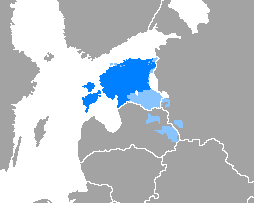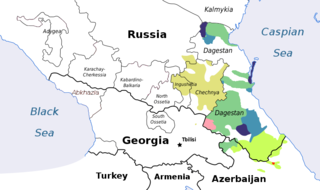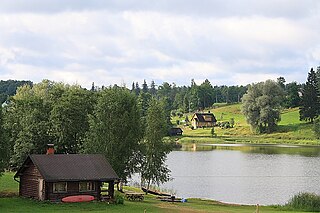
The Estonian language is a Uralic language of the Finnic branch spoken in Estonia. It is the official language of Estonia, spoken natively by about 1.1 million people; 922,000 people in Estonia and 160,000 outside Estonia. It is a Southern Finnic language and is the second-most-spoken language among all the Finnic languages.

The Northeast Caucasian languages, also called East Caucasian, or Nakh-Daghestanian languages, are a language family spoken in the Russian republics of Dagestan, Chechnya and Ingushetia and in northern Azerbaijan as well as in diaspora populations in Western Europe, Turkey and the Middle East. They are occasionally called North Caspian, as opposed to North Pontic for the Northwest Caucasian languages. All ethnic groups belonging to this family are predominantly Muslim, except Udis who are Christian.

The Baltic states, also known as the Baltic countries, Baltic republics, Baltic nations, or simply the Baltics, is a geopolitical term, typically used to group the three sovereign states in Northern Europe on the eastern coast of the Baltic Sea: Estonia, Latvia, and Lithuania. The term is not used in the context of cultural areas, national identity, or language, because while the majority of people in Latvia and Lithuania are Baltic people, the majority in Estonia are Finnic. The three countries do not form an official union, but engage in intergovernmental and parliamentary cooperation. The most important areas of cooperation between the three countries are foreign and security policy, defence, energy, and transportation.

Estonians are a Finnic ethnic group native to Estonia who speak the Estonian language.
The Red Book of the Peoples of the Russian Empire is a book about the small nations of the Russian Empire, the Soviet Union, and the Russia and some other post-Soviet states of today. It was published in Estonian in 1991 and in English in 2001.

Setos are an indigenous ethnic and linguistic minority in south-eastern Estonia and north-western Russia. Setos are mostly Seto-speaking Orthodox Christians of Estonian nationality. The Seto language belongs to the Finnic group of the Uralic languages. The Setos seek greater recognition, rather than having their language considered a dialect of Estonian. Along with Orthodox Christianity, vernacular traditional folk religion is widely practiced and supported by Setos.

Air Tindi is an airline based in Yellowknife, Northwest Territories, Canada. It operates scheduled and on demand charter services. Its main base is Yellowknife Airport and the airline was previously owned by the Arychuk family. The name Tindi means "the big lake" or "Great Slave Lake" in the local native Tłı̨chǫ Yatiì language.
The palatal ejective is a type of consonantal sound, used in some spoken languages. The symbol in the International Phonetic Alphabet that represents this sound is ⟨cʼ⟩.
The Andic languages are a branch of the Northeast Caucasian language family. They are often grouped together with the Avar language and (formerly) with the Tsezic (Didoic) languages to form an Avar–Andic branch of that family.
Tindi is a Northeast Caucasian language spoken in the Russian republic of Dagestan. Tindis call their language Idarab mitstsi meaning 'the language of the Idar village'. It is only an oral language; Avar or Russian are used in written communication instead. It has approximately 2,150 speakers.
Khwarshi is a Northeast Caucasian language spoken in the Tsumadinsky-, Kizilyurtovsky- and Khasavyurtovsky districts of Dagestan by the Khwarshi people. The exact number of speakers is not known, but the linguist Zaira Khalilova, who has carried out fieldwork in the period from 2005 to 2009, gives the figure 8,500. Other sources give much lower figures, such as Ethnologue with the figure 1,870 and the latest population census of Russia with the figure 1,872. The low figures are because many Khwarshi have registered themselves as being Avar speakers, because Avar is their literary language.

The Baltic Finnic peoples, Baltic Sea Finns, Baltic Finns, sometimes also Western Finnic peoples, often simply referred to as the Finnic peoples, are Finno-Ugric peoples inhabiting the Baltic Sea region in Northern Europe who speak Finnic languages, including the Finns proper, Estonians, Karelians, Veps, Izhorians, Votes, and Livonians, as well as their descendants worldwide. In some cases the Kvens, Ingrians, Tornedalians and speakers of Meänkieli are also included separately rather than as a part of Finns proper.
The Bagvalal language (Bagulal) is an Avar–Andic language spoken by the Bagvalals in southwestern Dagestan, Russia, along the right bank of the river Andi-Koisu and the surrounding hills, near the Georgian border. It is fairly similar to Tindi, its closest relative. The 2010 Russian census recorded 1,450 Bagvalal speakers.

Rõuge Parish is a rural municipality of Estonia, in Võru County. In 2006, it had a population of 2,045 and an area of 263.7 km².

Estonia, officially the Republic of Estonia, is a country on the eastern coast of the Baltic Sea in Northern Europe. It is bordered to the north by the Gulf of Finland with Finland on the other side, to the west by the Baltic Sea with Sweden on the other side, to the south by Latvia (343 km), and to the east by Lake Peipus and Russia (338.6 km). The territory of Estonia consists of a mainland and 2,222 islands in the Baltic Sea, covering a total area of 45,227 km2 (17,462 sq mi), water 2,839 km2 (1,096 sq mi), land area 42,388 km2 (16,366 sq mi), and is influenced by a humid continental climate. The official language of the country, Estonian, is the second-most-spoken Finnic language.
The Chamalals are an indigenous people of Dagestan, Russia living in a few villages in the Tsumadinsky District on the left bank of the Andi-Koisu river. They have their own language, Chamalal, and primarily follow Sunni Islam, which reached the Chamalal people around the 8th or 9th century. There are about 5,000 ethnic Chamalals. They are culturally similar to the Avars.
The Tindi are an indigenous people of Dagestan, Russia living in five villages in the center area around the Andi-Koisu river and the surrounding mountains in the northwestern part of southern Dagestan. They have their own language, Tindi, and primarily follow Sunni Islam, which reached the Tindi people around the 8th or 9th century. The only time that the Tindis were counted as a distinct ethnic group in the Russian Census was in 1926, when 3,812 reported to be ethnic Tindis. In 1967, there were about 5,000 ethnic Tindis. They are culturally similar to the Avars.
The Hunzibs are an indigenous people of Dagestan, Russia living in three villages in the Tsuntinsky District in the upper regions of the Avar-Koisu river area. They have their own language, Hunzib, and primarily follow Sunni Islam, which reached the Hunzib people around the 8th or 9th century. The only time that the Hunzibs were counted as a distinct ethnic group in the Russian Census was in 1926, when 105 people reported to be ethnic Hunzibs. Subsequently, they were listed as Avars in the Russian Censuses. In 1967, it was estimated that there were about 600 ethnic Hunzibs.







